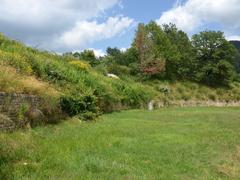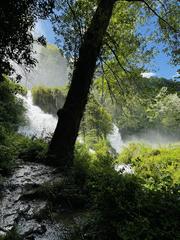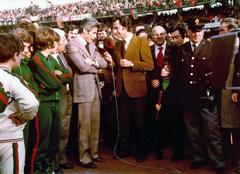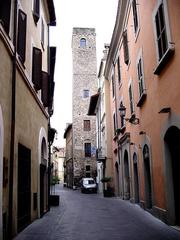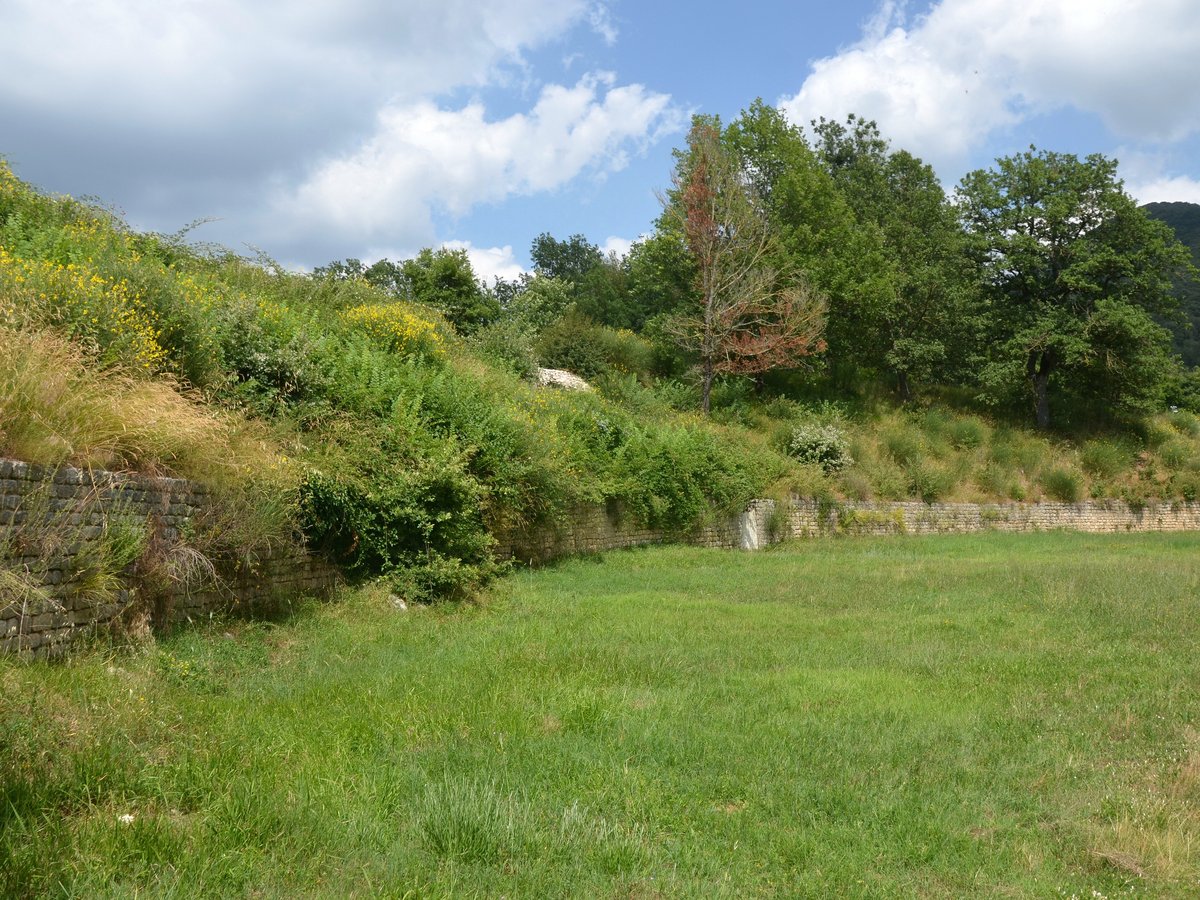
Carsulae Amphitheatre Visiting Hours, Tickets, and Travel Guide in Terni, Italy
Date: 14/06/2025
Introduction to Carsulae Amphitheatre and Its Historical Significance
Nestled in the Umbrian countryside near the city of Terni, the Carsulae Amphitheatre stands as one of the most significant and best-preserved Roman ruins in central Italy. Founded in the late 3rd century BCE and thriving under Augustus, Carsulae developed along the strategic Via Flaminia, connecting Rome to the Adriatic and facilitating military, commercial, and cultural exchanges. This ancient municipium reveals the depth of Romanization and urban sophistication that reached Italy’s interior (Soprintendenza Archeologia dell’Umbria; Via Flaminia - Britannica).
The amphitheatre, constructed in the late 1st century BCE or early 1st century CE, exemplifies Roman engineering by integrating natural slopes and local limestone with opus caementicium (Roman concrete). Capable of holding around 5,000 spectators, the venue hosted gladiatorial games, animal hunts, and festivals—key events reinforcing civic identity and imperial ideology (Carsulae - Parco Archeologico; Umbria Tourism).
Despite abandonment in late antiquity due to shifting trade routes, seismic activity, and medieval repurposing, the amphitheatre’s ruins remain remarkably intact. Archaeological excavations have illuminated Carsulae’s urban layout, revealing insights into Roman daily life and social structures (visitsitaly.com; lifeofman.co.uk). Today, the site is managed to ensure preservation while providing visitors with guided tours, educational exhibits, and cultural events.
This guide presents comprehensive information about the Carsulae Amphitheatre’s history, architecture, opening hours, ticketing, accessibility, travel tips, and nearby attractions—essential for anyone seeking to explore Umbria’s Roman heritage (Umbria Tourism; CAOS Museum; Sangeminitravelhub.com).
Carsulae Amphitheatre: A Roman Gem in Umbria
Carsulae is a unique archaeological destination where visitors can immerse themselves in the remnants of an ancient Roman city. The amphitheatre, a centerpiece of public life, continues to inspire awe through its preserved structure and evocative setting.
Historical Overview
Origins and Foundation
Carsulae’s foundation in the late 3rd century BCE was catalyzed by its placement along the Via Flaminia, a critical artery for military and commercial activity (Soprintendenza Archeologia dell’Umbria; Via Flaminia - Britannica). Evidence suggests pre-Roman settlement, but Roman urbanization transformed Carsulae into a thriving municipium, as reflected in its monumental architecture and civic spaces (Carsulae Archaeological Park).
Construction and Purpose of the Amphitheatre
The amphitheatre, dating from the late 1st century BCE to early 1st century CE, was built partially into a natural hillside using local stone and Roman concrete. Its elliptical arena (approximately 56 x 36 meters) could seat thousands, providing a stage for gladiatorial games, animal hunts, and public spectacles that reinforced Roman values and elite patronage (Carsulae - Parco Archeologico; Umbria Tourism).
Social and Cultural Significance
Amphitheatres like Carsulae’s were more than venues for entertainment; they were instruments of social order and Romanization. Events sponsored by local elites fostered civic pride and showcased allegiance to Rome. Inscriptions honor benefactors and officials, highlighting the integration of local and imperial traditions (Roman Amphitheatres - Oxford Classical Dictionary; Epigraphic Database Roma).
Decline, Abandonment, and Rediscovery
Carsulae’s decline began in late antiquity, accelerated by earthquakes and the diminishing importance of the Via Flaminia. The city was largely abandoned by the early Middle Ages (Carsulae - Soprintendenza Archeologia). Archaeological interest rekindled in the 19th and 20th centuries, leading to major excavations and restoration efforts (Carsulae Archaeological Park).
Visitor Information
Opening Hours
- High Season (Late March–Late October): 8:30 AM – 7:30 PM
- Low Season (Late October–Late March): 8:30 AM – 5:30 PM
- Ticket office closes 30 minutes before park closing (sangeminitravelhub.com).
Tickets
- Standard admission: €5
- Reduced admission (under 18): €2.50
- Free entry: First Sunday of each month
- Guided tours: Approximately €3 per person; available in Italian, English, and German (pre-booking recommended)
- Tickets available onsite or online via official sources (Carsulae Archaeological Park; Ticket Italia).
Accessibility
- Accessible paths and ramps available in main areas
- Some uneven ancient surfaces; wheelchair access is partial
- Visitor center includes restrooms and amenities (sangeminitravelhub.com).
Travel Tips
- Wear sturdy footwear for walking on ancient paving stones
- Bring water and sun protection, especially in summer
- Visit in spring or autumn for pleasant weather and lighter crowds
- Early morning or late afternoon recommended in summer
Getting There
- By car: 4 km north of San Gemini, with ample parking near the entrance (Wikipedia - Carsulae)
- By bus: Connections from Terni or San Gemini (limited schedules)
- Nearby attractions: Combine your visit with the medieval town of San Gemini, the Marmore Waterfalls, or Terni’s Roman sites (Savoring Italy).
Site Layout and Navigating the Ruins
The Carsulae Amphitheatre is adjacent to the Roman theatre and near the ancient Via Flaminia, making it easy to explore multiple monuments during your visit. The amphitheatre’s elliptical plan, partially sunken arena, and visible perimeter walls are accessible via five entry points. While the original seating has not survived, supporting galleries and the arena floor remain. Modern walkways and interpretive signage enhance visitor navigation and safety (Umbria Tourism).
Guided Tours and Educational Resources
Guided tours in Italian and English offer in-depth insights into Roman construction, daily life, and the history of Carsulae. Educational panels and brochures in multiple languages are available at the visitor center (CAOS Museum). School groups and families can benefit from thematic tours focused on archaeology and Roman culture.
Events and Performances
The amphitheatre occasionally hosts cultural events, from theatrical performances to historical reenactments, especially in summer. These events bring the ancient venue to life and often require advance ticket booking due to limited seating (Ticket Italia).
Facilities and Visitor Amenities
- Restrooms and a small café are located near the visitor center.
- Picnic areas and hiking trails nearby for those wishing to linger in the scenic surroundings.
- Visitor center includes an antiquarium with artifacts, maps, and educational materials (sangeminitravelhub.com).
Photography and Site Etiquette
- Personal photography is permitted throughout the site.
- Tripods or professional equipment may require special permission.
- Stay on marked paths and do not climb on the ruins or remove artifacts.
Nearby Attractions
- Roman Theatre: Adjacent to the amphitheatre, with well-preserved cavea and stage (viaggiando-italia.it).
- Forum and Basilica: Explore the civic heart of Carsulae with foundations of temples and the basilica (italia.it).
- Twin Temples and Arch of San Damiano: Prominent religious and monumental features along the Via Flaminia (umbriatourism.it).
- Thermal Baths and Water Management: Marvel at the remains of Roman baths and cisterns supplied by Mount Martani springs (worldhistory.org).
- Church of Saints Cosma and Damiano: Medieval church built with reclaimed Roman stone (umbriatourism.it).
- San Gemini: Charming medieval town nearby, perfect for dining and additional sightseeing.
Frequently Asked Questions (FAQ)
Q: What are the opening hours for Carsulae Amphitheatre?
A: High season: 8:30 AM – 7:30 PM; low season: 8:30 AM – 5:30 PM. Last entry is 30 minutes before closing.
Q: How do I purchase tickets?
A: Tickets are available onsite and online; guided tours may require advance booking.
Q: Is the site wheelchair accessible?
A: Main pathways are accessible, but some ancient surfaces remain uneven.
Q: Are guided tours available?
A: Yes, in Italian, English, and German. Pre-booking is advised.
Q: What nearby attractions are recommended?
A: The Roman theatre, forum, thermal baths, Arch of San Damiano, San Gemini, and Marmore Waterfalls.
Practical Tips for a Memorable Visit
- Book tickets and tours in advance, particularly during weekends and peak seasons.
- Allow 2–3 hours to explore the amphitheatre and surrounding monuments.
- Wear comfortable shoes and bring water, sun protection, and a camera.
- Check official websites for special events, updated hours, and accessibility information.
For current updates, visit the official Carsulae Archaeological Park website.
Visual Experience
Summary and Encouragement to Visit
The Carsulae Amphitheatre is a compelling symbol of Roman engineering and cultural depth in Umbria. Its well-preserved ruins, integrated with other monumental sites, offer an unforgettable experience for history lovers and casual visitors alike. Modern facilities, educational resources, and seasonal events ensure that your journey through Carsulae is both engaging and comfortable. By exploring this unique archaeological park, you’ll walk in the footsteps of ancient Romans and connect with Italy’s enduring heritage (Carsulae Archaeological Park; Oxford Classical Dictionary).
References
- Soprintendenza Archeologia dell’Umbria
- Via Flaminia - Britannica
- Carsulae Archaeological Park - Umbria Tourism
- Roman Amphitheatres - Oxford Classical Dictionary
- Carsulae - Parco Archeologico
- visitsitaly.com
- lifeofman.co.uk
- CAOS Museum - Carsulae Amphitheatre
- Ticket Italia - Carsulae Amphitheatre Tickets
- Turismo Narni Official Website
- Sangeminitravelhub.com
- viaggiando-italia.it
- italia.it
- worldhistory.org
- The Crazy Tourist - Best Things to Do in Terni
